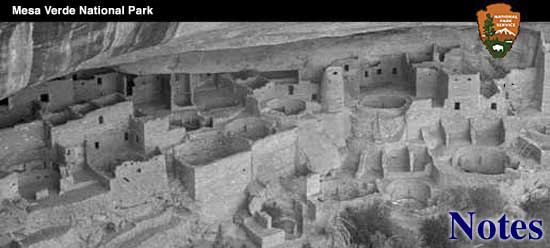

|
In response to many inquiries regarding the word Navaho as used in recent issues of "Mesa Verde Notes" a search has been made through the literature of the Southwest for uses of this form to verify its selection. Its origin is well described by the Franciscan Fathers1 in their "Ethnologic Dictionary of the Navaho Language". One interesting paragraph is as follows: "The word Navaho, or originally, Navajo, is first mentioned and applied to this tribe of Indians by Fray Alonzo Benavides O. F. M., in his "Memorial to the King of Spain" written in 1630. After describing the Gila Apaches, Benavides says that more than fifty leagues north of these "one encounters the Province of the Apaches of Navajo. Although they are the same Apache nation as the foregoing, they are subject and subordinate to another Chief Captain, and have a distinct mode of living. For those of back yonder did not use to plant, but sustained themselves by the chase; today we have broken land for them and taught them to plant. But these of Navajo are very great farmers, for that is what Navajo signifies—great planted fields."
Thus we might say that the older form of the word as spelled by the Spaniards was Navajo; meaning "people of the great planted fields." The Navahos call themselves: "Dine" which means men or people and in conversing with them they will tell you that "Dine" simply means "The People". A review of works published by various authors interested in Southwestern archaeology and ethnology enables us to compile a very interesting comparative list as to the uses of the word. Below are listed the writers using "ho" or "jo".
George Wharton James2 has an explanation for the use of NAVAHO and we quote the paragraph. "It will be observed that I follow the Americanized and rational form of spelling the name NAVAHO. Why people should consent to use the misleading and unnecessary form of the name NAVAJO, is beyond me. Every stranger to the Spanish tongue—and there are millions who are thus strange—naturally pronounce this Na-va-joe, and cannot be blamed. Yet it does give the One-who-knows the opportunity to laugh at him, and perhaps this is the reason the Spanish form is retained. Were the name one of Spanish origin we might be reconciled to that form of spelling, but as it is a name belonging to a tribe of Amerinds who were here and had been here for centuries when the Spaniards came, there is no reason why they should have fixed upon them forever a European method of spelling their name".
Justifying the use of NAVAHO we turn to the Dictionary of the English Language and find in Funk and Wagnalls: "Navaho, an important and rapidly increasing branch of Athapascan Indians dwelling in New Mexico and Arizona; employed in herding blanket making, silver smithing, and as laborers in railroad and ether public works. Navajo". This preference is also shown in Websters New International Dictionary. We present here the evidence of the common uses of the more modern and Americanized form of the word and local tendency is toward the use of NAVAHO, although NAVAJO is acceptable in all cases. | ||||||||||||
| <<< Previous | > Cover < | Next >>> |
vol4-2h.htm
14-Oct-2011